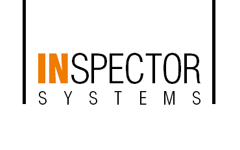Mission Visibility: Wall thickness reductions and material imperfections in nuclear technology and in industrial environments.
Throughout Europe in 2020, various projects were carried out with ultrasonic inspection robots from Inspector Systems under completely different conditions, such as high radiation exposure in nuclear power plants, in soiled district heating pipelines in urban areas or in buried gas pipelines. All these projects under different framework conditions required a specific robot functionality. Based on the Inspector Systems pipe robot technology, the self-driven and cable-connected ultrasonic inspection robots consist of several drive units, electronic pots and an ultrasonic inspection module, which are connected to each other by flexible bellows.
By means of adjustable pre-tension, the friction rollers of the drive units, which are provided with a special rubber coating, are pneumatically pressed against the inner wall of the pipe and provide the propulsion within the pipeline. This stabilises / centres the robot in the pipe and, depending on the application, it can traverse several bends with a bending radius =1.5D, vertical sections ±90° and diameter reductions as well as branches in the forward / reverse direction. A high degree of bendability enables insertion into the pipe system through narrow and restricted accesses, for example, open valves, flanges, etc.
A special cable (with special Kevlar elements to pull the robot safely out of the pipeline if necessary) from the robot to the control and evaluation unit outside is used for voltage / air supply, data transmission, control, etc. In addition to the control and ultrasonic signals, a separate water line is also carried for the independent coupling of the ultrasonic probes. The length of the cable is up to 300 m and is wound on a motorised cable drum with appropriate slip rings, thereby, the cable drum is in turn connected to the control unit of the ultrasonic inspection robot.
The ultrasonic inspection module developed by Inspector Systems consists of two to eight ultrasonic probes mounted as an array within a special water supply chamber. These ultrasonic probes are mounted on gimbals and moved against the inner wall of the pipe under spring load. A water-filled water inlet chamber made of low-friction plastic ensures a constant distance and the coupling of the ultrasound to the inner wall of the pipe. Depending on the application, probes with different geometries, angles of incidence or frequencies can be used. What this means in concrete terms is that unfilled pipelines can also be tested using this technology. The probes themselves and the adjustment mechanism are mounted on a rotating unit. This rotating unit is mounted between two pneumatically acting centring units which have been specially developed for internal pipe inspection.
Use of the ultrasonic inspection robots throughout Europe in nuclear power plants as well as in various urban supply lines above and below ground
In 2020, various types of the ultrasonic testing robots described above were used in several projects at home and abroad. Here, a "small" representative of the product range with a diameter of only 100 millimetres tested various contaminated pipelines in a European nuclear power plant. Other types of ultrasonic inspection robots inspected district heating pipelines in German and French cities for leaks, and in turn other types of ultrasonic inspection robots explored buried gas pipelines with a diameter of DN 600.
All projects, in which the individual pipe robots were used under a wide variety of difficult external conditions, were successfully completed. No matter whether high radiation exposure or underground buried lines in urban or industrial environments: With the help of Inspector Systems ultrasonic robot technology, it was possible to determine the integrity of various pipelines which would otherwise have remained hidden due to the difficult conditions.




